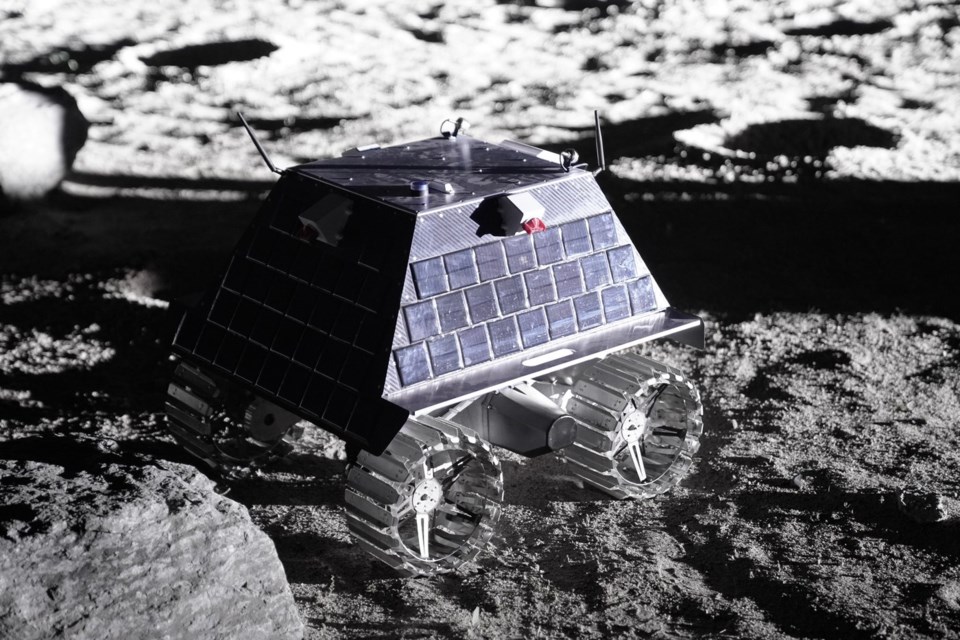ATHABASCA, Alta. — Residents of a northern Alberta town are over the moon that it could share its name with the first Canadian rover set to explore the dark, cold terrain of Earth's closest celestial neighbour.
The Canadian Space Agency is seeking a moniker for the four-wheeled, one-metre-tall robot set to scour for water and other resources on the moon — and is putting it to a vote.
Athabasca joins Courage, Glacier and Pol-R on the short list of names from which Canadians of all ages can choose.
Athabasca refers to the river that begins at the Columbia Icefield in Jasper National Park. Along its 1,200-kilometre journey to Lake Athabasca in northern Alberta and Saskatchewan, the river passes through the town of Athabasca, 145 kilometres north of Edmonton.
The town's mayor says the potential rover name is drawn from the river and not his community, but the list has created "quite the buzz" among its nearly 3,000 residents since it was released last week.
Robert Balay says with a laugh that he broke the agency's rule of one vote per person and cast two ballots to name the rover Athabasca — "once from my personal email and once from my work email."
He says the river is the town's main attraction and it's a cool surprise to think the rover could represent it from far, far away.
Balay says those in the town have been encouraging one another to vote before the online poll closes Dec. 20.
Among them is Shauna Zenteno, dean of Athabasca University's faculty of science.
She says she has told all her colleagues to vote, so the rover can put the town on the global and intergalactic maps.
"Northern Canada is somewhat neglected, so it's a suitable name. We're obviously excited," she said.
Michael Borody, whose family members have lived in Athabasca for more than a century, says he has voted.
"It's quite a strong name to see picked. It would be awesome to win."
The lunar rover would be the first of a fleet to be launched to the moon no earlier than 2026. Sandrine Masella, a spokesperson for the space agency, says its name has "to reflect the mission and have a link with Canada."
"The name Athabasca was chosen as Canada's rivers and streams have been the routes of the continent for millenniums and continue to be pathways of discovery, transport and exchange," Masella says.
Athabasca is the only name on the short list that references a Canadian landscape.
Caroline-Emmanuelle Morisset, a program scientist with the space agency, says Athabasca was selected out of 200 names proposed by agency employees and the Ontario-based company assigned to build the rover in 2022, Canadensys Aerospace Corp.
"Athabasca made it through all the screening steps," which included ensuring the name was bilingual, did not create copyright issues and wasn't already taken by another spacecraft or vehicle, Morisset says.
A committee within the agency came up with the short list.
Courage made the list because it represents "work that has led to the Canadian lunar rover," the space agency says on its website.
Glacier was chosen as a possible name because "that is what the rover will be looking for: water in the form of ice," the agency says.
Pol-R is a creative nod to the polar region of the moon that the rover is set to explore.
The agency says the rover's mission to the moon is important if humans are to establish a presence in space.
"Water is essential if we want to stay on the moon," it says on its website.
"We need water, and the oxygen it provides, in order to live. It would also be used to produce hydrogen, a source of energy to launch rockets from its surface. Bringing water from Earth would be very expensive and complex."
Morisset says the mission is the first of its kind by Canada.
The first rovers were sent by the United States during the Apollo missions, and a Chinese rover is currently sitting on the moon.
Morisset says the Canadian rover would be the first to explore the moon's South Pole.
It's built to withstand temperatures as low as -220 C. Its job is to collect data by capturing images, videos and temperatures.
The agency hopes the Canadian rover can survive at least four lunar nights, the equivalent of four to five months.
Morisset says NASA, which has partnered with Canada, is to carry the rover in a spacecraft. It would be controlled remotely from Earth and send data from space.
It's powered by batteries and solar energy.
Morisset says it took Canada 20 years to build the rover with help from universities and companies all over the world, including NASA, Oxford University in the United Kingdom and the University of Alberta in Edmonton.
"So it really feels more like a dream coming true … and hopefully we make great discoveries," she says.
"And having this naming contest is really to feel that people have a participation in the mission."
This report by The Canadian Press was first published Nov. 27, 2024.
— By Fakiha Baig in Edmonton
The Canadian Press




